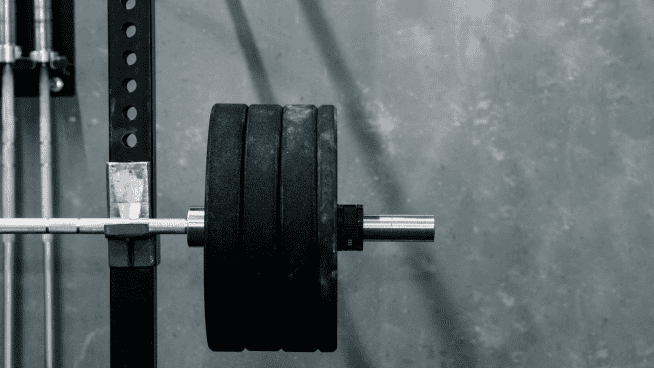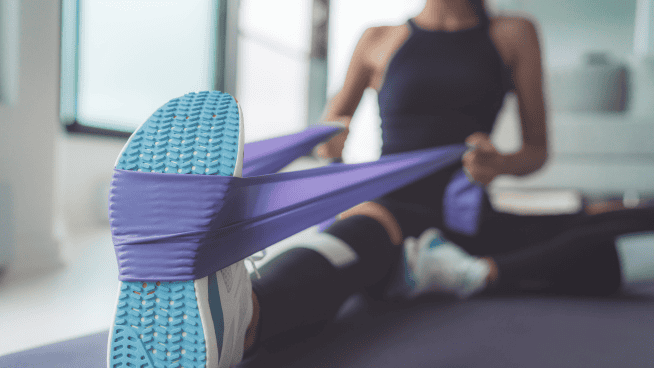5 Useless Rehab Methods Still Widely Used
Athletes are always looking for the next trick—whatever can heal their bodies faster and get them ready for competition. But there’s a lot of misinformation out there.
Here are five commonly used rehab and regen methods that are ineffective, and what you could be doing instead.
1. Kinesio Tape
Taping is a regular part of many athletes’ routine, but Kinesio tape is something else entirely. Kinesio tape first made waves during the 2008 Summer Olympics, and prominent athletes like James Harden wear it while playing. Some athletic trainers believe that Kinesio tape can help prevent injuries and improve blood flow.
But other medical experts view Kinesio tape, while not harmful, as nothing more than a placebo. The New York Times looked at the research and found that “today’s science does not show that kinesiology tape is preferable in any way to plain athletic tape for the management or prevention of sports injuries.”
Sometimes athletes misuse plain athletic tape, too. Taping should be done by a trained, certified specialist.
2. Static Stretching
When most of us were little kids playing weekend soccer or basketball, we were taught about the importance of stretching as part of a warm-up. We sat down, tried to reach our toes, and worked to complete exercises that were supposed to loosen up our bodies and prevent injuries.
RELATED: Dynamic and Static Stretching: Which Method is Better?
But the latest research shows that static stretching before a workout or sporting event is potentially harmful. Holding some stretching poses for 30 seconds can loosen your muscles, but can also decrease their force and bend your body in ways it is not meant to bend.
Dynamic stretching is the better choice. By moving while stretching, you keep your muscles active and ready to go.
With that said, static stretching after a workout is a great way to increase length in a muscle, which increases mobility in the joint on which that muscle acts.
3. Anti-Inflammatory Medication
Sometimes, when you are feeling sore or in pain after a long day of training, you might pop some Advil to feel better and ease your inflamed muscles.
But you have to remember what inflammation is. When you exercise, you damage muscle tissue. To repair that tissue, your body releases chemicals and macrophages and brings in badly needed blood and oxygen. This process of minor damage and repair is what, biologically, strengthens your muscles.
Taking Advil can make you feel better, but it can also reduce the benefits of training. At least one study showed that “athletes who regularly take NSAIDs before exercise may have reduced tissue adaptation to prevailing loads, potentially predisposing them to future injury.”
Taking Ibuprofen is OK after an actual injury, like a sprain, but you should also see a doctor. But in terms of regular maintenance, don’t make a habit of taking anti-inflammatory medication.
4. Ice
If you exercise regularly, you’ve probably heard that ice is not as good for your body as was once believed. Even the man who came up with the RICE acronym (Rest, Ice, Compression, Elevation), Gabe Mirkin, warns about the dangers of ice.
Ice does help numb pain, but it also restricts blood flow; and though this reduces pain, it also slows down the healing process.
Ice is useful in cases of truly unbearable pain, but under those circumstances you should be seeing a doctor.
Heat is a much better choice for low-level injuries, as it increases the blood supply and quickens the healing process.
RELATED: Why You Shouldn’t Ice After a Workout
5. Rest
The first part of the RICE acronym is also problematic. Of course, you shouldn’t go for a jog right after you sprain your ankle. But too many people who get injured stop exercising entirely until the injury gets better. The problem is that if your muscles do nothing for too long, they start to weaken again, becoming more susceptible to future re-injuries.
You should keep doing some exercise and training within three to five days after an injury. Even in the case of a catastrophic injury where you can’t use a certain muscle at all, training your other muscles will help the injured muscle’s recovery. Proper compression can also help relieve pain and keep you active, even with a slight injury.
[cf]skyword_tracking_tag[/cf]RECOMMENDED FOR YOU
MOST POPULAR
5 Useless Rehab Methods Still Widely Used
Athletes are always looking for the next trick—whatever can heal their bodies faster and get them ready for competition. But there’s a lot of misinformation out there.
Here are five commonly used rehab and regen methods that are ineffective, and what you could be doing instead.
1. Kinesio Tape
Taping is a regular part of many athletes’ routine, but Kinesio tape is something else entirely. Kinesio tape first made waves during the 2008 Summer Olympics, and prominent athletes like James Harden wear it while playing. Some athletic trainers believe that Kinesio tape can help prevent injuries and improve blood flow.
But other medical experts view Kinesio tape, while not harmful, as nothing more than a placebo. The New York Times looked at the research and found that “today’s science does not show that kinesiology tape is preferable in any way to plain athletic tape for the management or prevention of sports injuries.”
Sometimes athletes misuse plain athletic tape, too. Taping should be done by a trained, certified specialist.
2. Static Stretching
When most of us were little kids playing weekend soccer or basketball, we were taught about the importance of stretching as part of a warm-up. We sat down, tried to reach our toes, and worked to complete exercises that were supposed to loosen up our bodies and prevent injuries.
RELATED: Dynamic and Static Stretching: Which Method is Better?
But the latest research shows that static stretching before a workout or sporting event is potentially harmful. Holding some stretching poses for 30 seconds can loosen your muscles, but can also decrease their force and bend your body in ways it is not meant to bend.
Dynamic stretching is the better choice. By moving while stretching, you keep your muscles active and ready to go.
With that said, static stretching after a workout is a great way to increase length in a muscle, which increases mobility in the joint on which that muscle acts.
3. Anti-Inflammatory Medication
Sometimes, when you are feeling sore or in pain after a long day of training, you might pop some Advil to feel better and ease your inflamed muscles.
But you have to remember what inflammation is. When you exercise, you damage muscle tissue. To repair that tissue, your body releases chemicals and macrophages and brings in badly needed blood and oxygen. This process of minor damage and repair is what, biologically, strengthens your muscles.
Taking Advil can make you feel better, but it can also reduce the benefits of training. At least one study showed that “athletes who regularly take NSAIDs before exercise may have reduced tissue adaptation to prevailing loads, potentially predisposing them to future injury.”
Taking Ibuprofen is OK after an actual injury, like a sprain, but you should also see a doctor. But in terms of regular maintenance, don’t make a habit of taking anti-inflammatory medication.
4. Ice
If you exercise regularly, you’ve probably heard that ice is not as good for your body as was once believed. Even the man who came up with the RICE acronym (Rest, Ice, Compression, Elevation), Gabe Mirkin, warns about the dangers of ice.
Ice does help numb pain, but it also restricts blood flow; and though this reduces pain, it also slows down the healing process.
Ice is useful in cases of truly unbearable pain, but under those circumstances you should be seeing a doctor.
Heat is a much better choice for low-level injuries, as it increases the blood supply and quickens the healing process.
RELATED: Why You Shouldn’t Ice After a Workout
5. Rest
The first part of the RICE acronym is also problematic. Of course, you shouldn’t go for a jog right after you sprain your ankle. But too many people who get injured stop exercising entirely until the injury gets better. The problem is that if your muscles do nothing for too long, they start to weaken again, becoming more susceptible to future re-injuries.
You should keep doing some exercise and training within three to five days after an injury. Even in the case of a catastrophic injury where you can’t use a certain muscle at all, training your other muscles will help the injured muscle’s recovery. Proper compression can also help relieve pain and keep you active, even with a slight injury.
[cf]skyword_tracking_tag[/cf]









